Raaga Based Song of the Day: Madhuban mein Radhika naache re…….
Raag Hamir, Tal Tintal
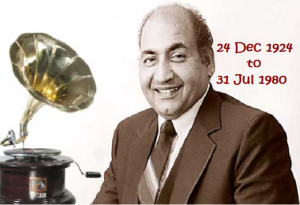 Tomorrow is the death anniversary of the greatest Indian playback singer: Mohammad Rafi (Please read: ‘The Best Of Old Hindi Songs: Rafi, Shakeel, Naushad and Dilip Kumar Together‘, as is the case with this song). I have saved this song and raaga for you for this occasion. Indeed, I was tempted to give it to you day before yesterday when I told you about Jaltarang in the value-added learning since this song has one of the best accompaniment of Jaltarang, in the end. However, I stopped myself since Jaltarang wasn’t played by the lead actor: Dilip Kumar. I shall, therefore, tell you about Sitar today, which is what he is seen playing in the song.
Tomorrow is the death anniversary of the greatest Indian playback singer: Mohammad Rafi (Please read: ‘The Best Of Old Hindi Songs: Rafi, Shakeel, Naushad and Dilip Kumar Together‘, as is the case with this song). I have saved this song and raaga for you for this occasion. Indeed, I was tempted to give it to you day before yesterday when I told you about Jaltarang in the value-added learning since this song has one of the best accompaniment of Jaltarang, in the end. However, I stopped myself since Jaltarang wasn’t played by the lead actor: Dilip Kumar. I shall, therefore, tell you about Sitar today, which is what he is seen playing in the song.
We have completed fifty-two days of Raaga Based Songs of the Day. Our first post in the series was titled ‘Raaga Based Song Of The Day #1’ and the song was a Mohammad Rafi and Lata Mangeshkar song from the 1970 Shakti Samanta movie Pagla Kahin Ka: Tum mujhe youn bhula na paoge. It is in Raag Jhinjhoti, Tal Kaherava.
Our fifty-second post was titled ‘Raaga Based Song Of The Day #52’ and the song (qawwali) was a Mohammad Rafi, Asha Bhosle song from the 1977 Nasir Husaain movie Hum Kisise Kum Nahin: Hum kisise kum nahin. It is in Raag Kalavati, Tal Kaherava.
This blog has a number of posts on Raaga based songs in Hindi movies titled similarly; for example: ‘The Best Raaga Based Songs in Hindi Movies – Raaga Darbari Kanada – Part I‘.
In the last fifty-two days of sharing Raaga based songs of the day, I have given you songs based on Raag Jhinjhoti, Gara, Bhimpalasi, Madhuvanti, Shivaranjani, Bihag, Pahadi, Sarang, Pilu, Bhairavi, Khammaj, Charukesi, Kalyan or Yaman, Desh, Malgunji, Kirwani, Kedar, Bageshri, Megh Malhar, Bhupali, Ahir Bhairav, Malkaush, Mand, Adana, Kafi, Rageshri, Jaunpuri, Tilang, Janasammohini, Chayanat, Shuddha Kalyan, Gaur Sarang, Jogiya, Asavari, Maru Bihag, Durga, Lalit, Puria Dhanashri, Bhinna Sahdja, Sohani, Multani, Patdeep, Jaijaiwanti, Tilak Kamod, Hemant, Basant Mukhari, Gujri Todi and Kalavati. The only two raag that has been repeated so far are Pahadi, the raaga of my home place in the Himalayas, and Maru Bihag. That makes a total of 48 raagas so far; today’s one is 49th.
Today, I give you a song in Raag Hamir, Tal Tintal.
However, first, lets take up the value added learning of today. Today, we shall learn about Sitar.
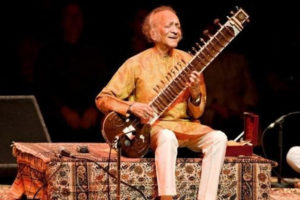 Sitar is a later variation of the Indian instrument Veena and that is the reason I am giving it to you after having told you about the ancient instrument Veena (Please read: ‘Raaga Based Song Of The Day #49‘). When I gave you the history of the Hindustani Music (Please read: ‘Raaga Based Song Of The Day #28‘), I told you how the old Sanskrit/Hindi music was fuzed with the Persian in Mughal Courts. Sitar came about to conform to Persian instrument Setar (three strings). Sitar, therefore, flourished from 16th century onwards in our sub-continent. However, there was one person who made this into a global phenomenon and that was Pandit Ravi Shankar. Some of us who followed this phenomenon in the 1950s and 60s saw even the Western groups employing Sitar in their music. The most prominent of them were The Beatles, The Rolling Stones and The Doors.
Sitar is a later variation of the Indian instrument Veena and that is the reason I am giving it to you after having told you about the ancient instrument Veena (Please read: ‘Raaga Based Song Of The Day #49‘). When I gave you the history of the Hindustani Music (Please read: ‘Raaga Based Song Of The Day #28‘), I told you how the old Sanskrit/Hindi music was fuzed with the Persian in Mughal Courts. Sitar came about to conform to Persian instrument Setar (three strings). Sitar, therefore, flourished from 16th century onwards in our sub-continent. However, there was one person who made this into a global phenomenon and that was Pandit Ravi Shankar. Some of us who followed this phenomenon in the 1950s and 60s saw even the Western groups employing Sitar in their music. The most prominent of them were The Beatles, The Rolling Stones and The Doors.
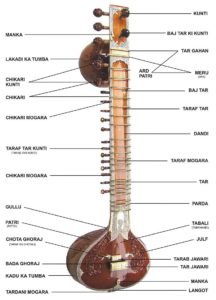 Typically measuring about 1.2 metres (4 feet) in length, the Sitar has a deep pear-shaped gourd body; a long, wide, hollow wooden neck; both front and side tuning pegs; and 20 arched movable frets. Its strings are metal; there are usually five melody strings, one or two drone strings used to accentuate the rhythm or pulse, and as many as 13 sympathetic strings beneath the frets in the neck that are tuned to the notes of the raaga (melodic framework of the performance). The convex metal frets are tied along the neck, which enables them to be moved as needed. The sitar often has a resonating gourd under the pegbox end of the neck; this balances the weight of the instrument and helps support it when it is not being played. Musicians hold the sitar at a 45° angle on their laps while seated. They pluck the strings with a wire plectrum worn on the right forefinger while the left hand manipulates the strings with subtle pressure on or between the frets and with sideways pulls of the strings.
Typically measuring about 1.2 metres (4 feet) in length, the Sitar has a deep pear-shaped gourd body; a long, wide, hollow wooden neck; both front and side tuning pegs; and 20 arched movable frets. Its strings are metal; there are usually five melody strings, one or two drone strings used to accentuate the rhythm or pulse, and as many as 13 sympathetic strings beneath the frets in the neck that are tuned to the notes of the raaga (melodic framework of the performance). The convex metal frets are tied along the neck, which enables them to be moved as needed. The sitar often has a resonating gourd under the pegbox end of the neck; this balances the weight of the instrument and helps support it when it is not being played. Musicians hold the sitar at a 45° angle on their laps while seated. They pluck the strings with a wire plectrum worn on the right forefinger while the left hand manipulates the strings with subtle pressure on or between the frets and with sideways pulls of the strings.
Some of the memorable songs in Hindi movies (there are many indeed) with Sitar are: Tora man darpan kehlaaye (Movie Kaajal, Raag Darbari Kanada, Tal Kaherava, composition of Ravi on Sahir Ludhianvi’s lyrics), Ham tere pyaar mein saara alam (Movie Dil Ek Mandir, composition of Shankar Jaikishan on the lyrics of Hasrat Jaipuri), and Man re kaahe na dheer dhare (Movie Chitralekha, composition of Roshan on the lyrics of Sahir Ludhianvi, Raag Kalyan, Tal Kaherava.
As far as international scene is concerned, I am giving you just one song (from scores of them). This is the popular Rolling Stones song: Paint It Black:
As I mentioned, today’s song is composed in Raag Hamir, Tal Tintal.
Hamir belongs to Kalyan Thaat in Bhatkhande’s system of raagas. Its Jati is Audhav-Sampoorna Vakra, ie, five notes in Aaroha (with the exception of Rishab and Pancham) and all seven in Avaroha, except that some of them are crooked and not in ascending or descending order. At this stage, I also wish to point out that Aaroha and Avroha merely tell us about the Swars employed and their approximate sequence. These do not entirely reflect the constitution of the raaga. To this, I also want to add that Raaga-Thaat association is also just a standard linkage and many raagas, such as this one (some say, this raaga reflects some of Bilawal ang), show linkages with more than one Thaat.
Raag Hamir is known to project a vigorous, dramatic mien and hence in the Veer Rasa. It is occasionally referred to as Hamir Kalyan (not to be confused with Hamir Kalyani of the Carnatic paddhati, which is the equivalent of the Hindustani Kedar). This enthusiastic raaga reflects vivacity and you would see it in the song that I have selected for you.
One finds in Hamir a variety of old Dhrupad, Dhamar and Khayal compositions. Just as Nand is a staple of the Agra/Atrauli diet, so it is with Hamir and the musicians of the Gwalior Gharana.
Hamir is to be normally sung during the second prahar of night, ie, 9 PM to Midnight.
As far as Tintal is concerned, I have already told you enough on the 19th and 25th days.
Two of the popular songs composed in this raaga are: Shri Ramchandra kriplu bhaja mana (Tal Rupaktal), and Sur ki gati main kya jaanu (Tal Kaherava).
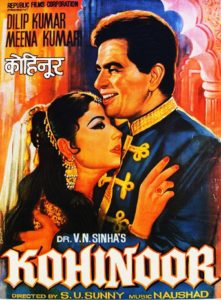 Today’s song (qawwali) is from the 1960 SU Sunny movie Kohinoor starring Dilip Kumar, Meena Kumari, Leela Chitnis and Kumkum.
Today’s song (qawwali) is from the 1960 SU Sunny movie Kohinoor starring Dilip Kumar, Meena Kumari, Leela Chitnis and Kumkum.
Songs of the movie were penned by my favourite lyricist Shakeel Badayuni and composed by Naushad. Mohammad Rafi sang this delightful song to the accompaniment of many Indian classical musical instruments such as Tabla, Jaltarang, Sitar, Tanpura, Sarangi, Sarod, Rudra Veena and Mridangam. Hats off to Naushad Ali for having included virtually all important Indian Classical Music instruments in this song. Dilip Kumar won the Filmfare Best Actor award for the movie. The movie was devised so as to give the lead actor Dilip Kumar a break from tragedy roles because of which he had gone into depression.
Half the length of the accompanying video is vocal music to the accompaniment of instruemnts. The other half is pure instrumental sargam and alaap. Kumkum dances on the song, being one of the most accomplished dancers in Hindi movies of that era.
Please enjoy Mohammad Rafi sing a composition of his mentor Naushad Ali in Raag Hamir, Tal Tintal, on the lyrics of Shakeel Badayuni: Madhuban mein Radhika naache re….
Madhuban me.n Raadhikaa naache re -2
Giradhar kii muraliyaa baaje re -2
Madhuban me.n…
Pag me.n ghu.Ngharuu baa.Ndhake, aa…
Pag me.n ghu.Ngharuu baa.Ndhake
Ghu.NghaTaa mukh par Daal ke
Nainan me.n kajaraa lagaake re
Madhuban me.n…
Dolat chham-chham kaaminii, aa…
Dolat chham-chham kaaminii
Chamakat jaise daaminii
Cha.nchal pyaarii chhavi laage re
Madhuban me.n…
Mrida.ng baaje titakitadhuum titakitadhuum taa taa -2
Na chaka chuum chuum thaa thay thaa thay
Chaka chuum chuum chana na na chuum chuum chana na na
Kran taa kran taa kran taa dhaa dhaa dhaa
Madhuban me.n Raadhikaa naache re
Madhuban me.n Raadhikaa
NI sA re sA gA re mA gA pA mA
DhA pA nI dhA sA nI re sA
Re sA nI dhA pA mA
PA dhA nI sA re sA nI dhA pA mA
PA gA mA
DhA pA gA mA re sA
Madhuban me.n Raadhikaa naache re
SA sA sA nI dhA pA mA
PA dhA pA gA mA re sA nI re sA
SA sA gA mA dhA dhA nI dhA sA
Madhuban me.n Raadhikaa naache re
Madhuban me.n Raadhikaa
O de nA dir dir dhA nI tA dhA re dIm dIm tA nA nA
NA dir dir dhA nI tA dhA re dIm dIm tA nA nA
NA dir dir dhA nI tA dhA re dIm dIm tA nA nA
NA dir dir dhA nI tA dhA re
O de tana dir dir tana dir dir dir dir duum dir dir dir
Dhaa titakita tak duum titakita tak
Titakita titakita tA dhA nI
NA dir dir dhA nI tA dhA re …
We have intended to learn about Raaga based music whilst we entertain ourselves with Raaga based songs. So, lets, once again, take stock of our collective learning so far:
- On the first day we learnt about the Raaga system devised by Pandit Vishnu Narayan Bhatkhande, which is the prevalent system in Hindustani Classical Music and based on ten Thaats.
- On the second day we learnt about Tal or Taal.
- On the third day we learnt about characteristics of Raagas that included Swar, Jati, Thaat, Arohana and Avarohana, Vadi, Samvadi and Pakad.
- On the fourth day, we learnt about Sargam.
- On the fifth day, we learnt about notations used in Indian classical music or simply Swar Lipi.
- On the sixth day, we learnt about the Ras (sentiments) that Raagas evoke.
- On the seventh day, we learnt about various types of Swar: Shuddha, Achal, Vikrut, Komal and Teevra.
- On the eighth day, we learnt the parts of a composition in Indian Classical Music.
- On the ninth day, we learnt the names of some of the popular instruments used in Indian Classical Music.
- On the tenth day, we learnt about the sources of names of Raagas.
- On the eleventh day, we learnt about why Bhairavi is the first raag to be taught to beginners and also why it is the last in a performance.
- On the twelfth day, we learnt about Khammaj Thaat.
- On the thirteenth day, we learnt about Tal Punjabi Theka or Sitarkhani.
- On the fourteenth day, we learnt about Alap.
- On the fifteenth day, we learnt about List of Raagas (Raagmala) in my favourite book: Sri Guru Granth Sahib.
- On the sixteenth day, we learnt about tips for raaga identification.
- On the seventeenth day, we learnt the basics of Gharana system.
- On the eighteenth day, we learnt about Filmi Sangeet.
- On the nineteenth day, we learnt about the commonest Tal in Raagas: Tintal.
- On the twentieth day, we learnt about the Kafi Thaat.
- On the twenty-first day, we learnt a little more in detail about the classification of Raagas.
- On the twenty-second day, we learnt the essential differences between Bhairavi and Bhairav.
- On the twenty-third day, we learnt a little more in detail about the Jati or Jaati of a raaga.
- On the twenty-fourth day, we learnt details of Thaat Bilawal, the most basic thaat in the Bhatkhande’s system of raagas.
- On the twenty-fifth day, we learnt about Tintal.
- On the twenty-sixth day, we learnt in detail about the Raaga – Samay linkage.
- On the twenty-seventh day, we learnt about Lehar.
- On the twenty-eighth day, we learnt about the history of the Hindustani Music.
- On the twenty-ninth day, we learnt about Dhrupad.
- On the thirtieth day, we learnt about Rupaktal that I was introduced to, a few months back, by my friend Anand Desai.
- On the thirty-first day, we learnt about Khayal.
- On the thirty-second day, we learnt about Thumri.
- On the thirty-third day, we learnt about Tappa.
- On the thirty-fourth day, we learnt about Tarana.
- On the thirty-fifth day, we learnt about Tal Dipchandi (Moghali).
- On the thirty-sixth day, we learnt about Tabla.
- On the thirty-seventh day, we learnt about Kirtan.
- On the thirty-eighth day, we learnt about Pakhawaj.
- On the thirty-ninth day, we learnt about Hori.
- On the fortieth day, we learnt about Dadra.
- On the forty-first day, we learnt about Kajri.
- On the forty-second day, we learnt about Chaiti.
- On the forty-third day, we learnt about Sarangi.
- On the forty-fourth day, we learnt about Shehnai.
- On the forty-fifth day, we learnt about Sarod.
- On the forty-sixth day, we learnt about Bansuri.
- On the forty-seventh day, we learnt about Ektal and Tanpura.
- On the forty-eighth day, we learnt about Veena.
- On the forty-ninth day, we repeated our learning of Veena with a small excitement added.
- On the fiftieth day, we learnt about Dilruba/Esraj.
- On the fifty-first day, we learnt about Jaltarang.
- On the fifty-second day we learnt about Qawwali.
- And today, on the fifty-third day, we learnt about Sitar.
There is much more still to be learnt and enjoyed.
Please stay tuned!
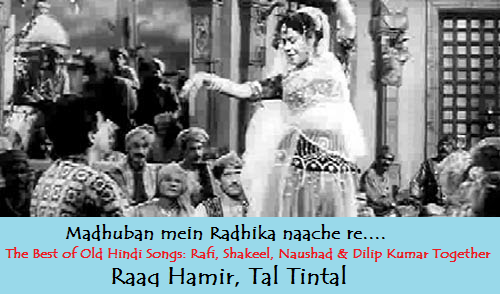
Paint black an excellent song . Other than Sitar Vadak , two more people playing …. are these Tanpuras ? .
Madhuban mein is just a remarkable composition, a distinguished mixture of classical dance and the music produced out of so many classical music instruments.
Thank you Jaswant. Paint Black is a fusion piece between Sitar and Western instruments.